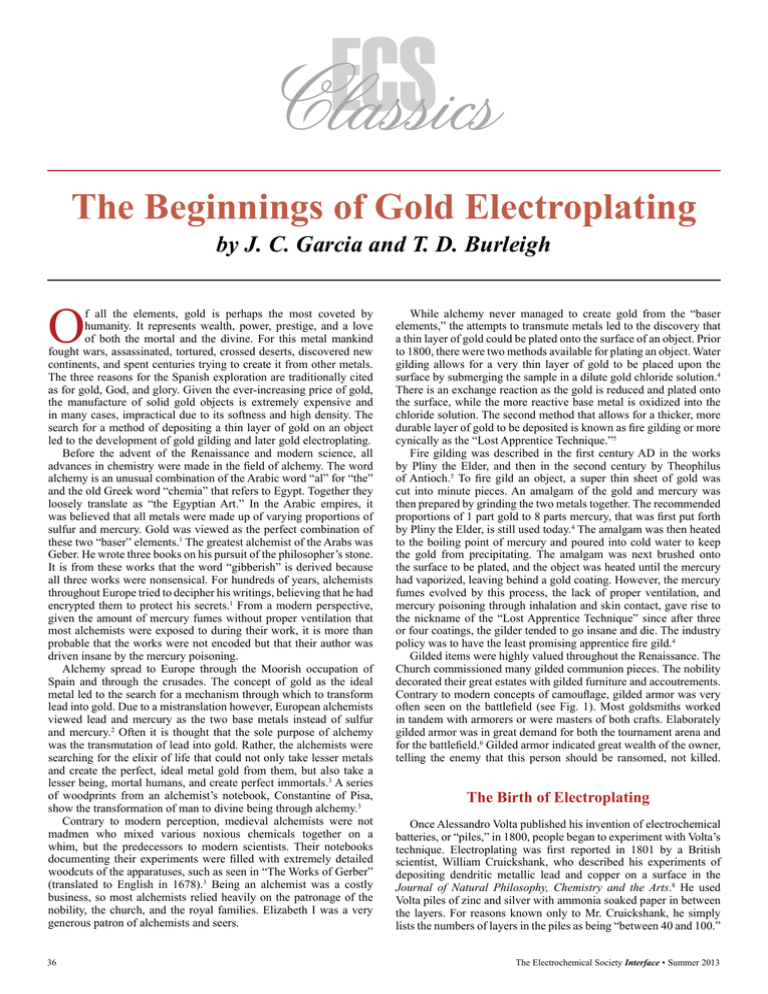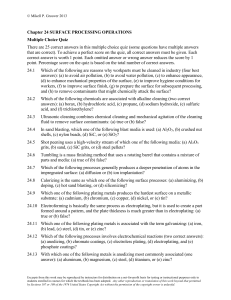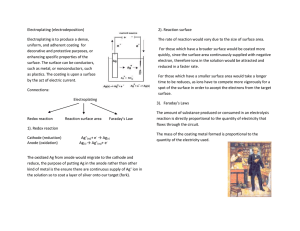The Beginnings of Gold Electroplating
advertisement

ECS Classics The Beginnings of Gold Electroplating by J. C. Garcia and T. D. Burleigh O f all the elements, gold is perhaps the most coveted by humanity. It represents wealth, power, prestige, and a love of both the mortal and the divine. For this metal mankind fought wars, assassinated, tortured, crossed deserts, discovered new continents, and spent centuries trying to create it from other metals. The three reasons for the Spanish exploration are traditionally cited as for gold, God, and glory. Given the ever-increasing price of gold, the manufacture of solid gold objects is extremely expensive and in many cases, impractical due to its softness and high density. The search for a method of depositing a thin layer of gold on an object led to the development of gold gilding and later gold electroplating. Before the advent of the Renaissance and modern science, all advances in chemistry were made in the field of alchemy. The word alchemy is an unusual combination of the Arabic word “al” for “the” and the old Greek word “chemia” that refers to Egypt. Together they loosely translate as “the Egyptian Art.” In the Arabic empires, it was believed that all metals were made up of varying proportions of sulfur and mercury. Gold was viewed as the perfect combination of these two “baser” elements.1 The greatest alchemist of the Arabs was Geber. He wrote three books on his pursuit of the philosopher’s stone. It is from these works that the word “gibberish” is derived because all three works were nonsensical. For hundreds of years, alchemists throughout Europe tried to decipher his writings, believing that he had encrypted them to protect his secrets.1 From a modern perspective, given the amount of mercury fumes without proper ventilation that most alchemists were exposed to during their work, it is more than probable that the works were not encoded but that their author was driven insane by the mercury poisoning. Alchemy spread to Europe through the Moorish occupation of Spain and through the crusades. The concept of gold as the ideal metal led to the search for a mechanism through which to transform lead into gold. Due to a mistranslation however, European alchemists viewed lead and mercury as the two base metals instead of sulfur and mercury.2 Often it is thought that the sole purpose of alchemy was the transmutation of lead into gold. Rather, the alchemists were searching for the elixir of life that could not only take lesser metals and create the perfect, ideal metal gold from them, but also take a lesser being, mortal humans, and create perfect immortals.3 A series of woodprints from an alchemist’s notebook, Constantine of Pisa, show the transformation of man to divine being through alchemy.3 Contrary to modern perception, medieval alchemists were not madmen who mixed various noxious chemicals together on a whim, but the predecessors to modern scientists. Their notebooks documenting their experiments were filled with extremely detailed woodcuts of the apparatuses, such as seen in “The Works of Gerber” (translated to English in 1678).3 Being an alchemist was a costly business, so most alchemists relied heavily on the patronage of the nobility, the church, and the royal families. Elizabeth I was a very generous patron of alchemists and seers. 36 While alchemy never managed to create gold from the “baser elements,” the attempts to transmute metals led to the discovery that a thin layer of gold could be plated onto the surface of an object. Prior to 1800, there were two methods available for plating an object. Water gilding allows for a very thin layer of gold to be placed upon the surface by submerging the sample in a dilute gold chloride solution.4 There is an exchange reaction as the gold is reduced and plated onto the surface, while the more reactive base metal is oxidized into the chloride solution. The second method that allows for a thicker, more durable layer of gold to be deposited is known as fire gilding or more cynically as the “Lost Apprentice Technique.”5 Fire gilding was described in the first century AD in the works by Pliny the Elder, and then in the second century by Theophilus of Antioch.5 To fire gild an object, a super thin sheet of gold was cut into minute pieces. An amalgam of the gold and mercury was then prepared by grinding the two metals together. The recommended proportions of 1 part gold to 8 parts mercury, that was first put forth by Pliny the Elder, is still used today.4 The amalgam was then heated to the boiling point of mercury and poured into cold water to keep the gold from precipitating. The amalgam was next brushed onto the surface to be plated, and the object was heated until the mercury had vaporized, leaving behind a gold coating. However, the mercury fumes evolved by this process, the lack of proper ventilation, and mercury poisoning through inhalation and skin contact, gave rise to the nickname of the “Lost Apprentice Technique” since after three or four coatings, the gilder tended to go insane and die. The industry policy was to have the least promising apprentice fire gild.4 Gilded items were highly valued throughout the Renaissance. The Church commissioned many gilded communion pieces. The nobility decorated their great estates with gilded furniture and accoutrements. Contrary to modern concepts of camouflage, gilded armor was very often seen on the battlefield (see Fig. 1). Most goldsmiths worked in tandem with armorers or were masters of both crafts. Elaborately gilded armor was in great demand for both the tournament arena and for the battlefield.6 Gilded armor indicated great wealth of the owner, telling the enemy that this person should be ransomed, not killed. The Birth of Electroplating Once Alessandro Volta published his invention of electrochemical batteries, or “piles,” in 1800, people began to experiment with Volta’s technique. Electroplating was first reported in 1801 by a British scientist, William Cruickshank, who described his experiments of depositing dendritic metallic lead and copper on a surface in the Journal of Natural Philosophy, Chemistry and the Arts.8 He used Volta piles of zinc and silver with ammonia soaked paper in between the layers. For reasons known only to Mr. Cruickshank, he simply lists the numbers of layers in the piles as being “between 40 and 100.” The Electrochemical Society Interface • Summer 2013 By attaching a silver wire to the bottom layer of zinc and the other to the top layer of silver of the Volta pile, and then placing the ends into a lead acetate solution, he was able to produce, “fine needles of a metallic material at the silver wire [the wire attached to the bottom of the Volta pile].” The experiment was also repeated with a copper solution. An Italian scientist, Luigi Brugnatelli, was the first to publish (in 1805) on the use of Volta piles to deposit a layer of gold onto another metallic surface.9 He published his experiments on plating gold onto silver medals in a letter to the Belgium Journal of Physics and Chemistry. A brief mention of this work may also be found in Philosophical Magazine of the Royal Irish Academy, “I have lately gilt in a complete manner two large silver medals, by bringing them into communication by means of a steel wire, with a negative pole of a voltaic pile, and keeping them one after the other immersed in ammoniuret of gold newly made and well saturated.”10 While Alessandro Volta was received by French Emperor Napoleon Bonaparte with great pomp and circumstance (see the painting by Guiseppe Bertini11) and was made a count, Brugnatelli was not well received by Napoleon. The Emperor did not approve of the idea of the lower classes having access to gold plated items. Due to his falling out with Napoleon Bonaparte and thus the French Academy of Sciences, Brugnatelli’s work remained unknown outside of Italy.10 After Brugnatelli, there was very little reported on gold-plating until 1840 when the first English patent for a gold electroplating process was issued to Henry and George Elkington. With the collaboration of John Wright, the brothers developed a potassium cyanide bath for electroplating gold.12 Elkington & Co was later contracted to supply all of the plated flatware for the ill-fated RMS Titanic.13 By the 1850s, gold, silver, copper, and many other metals were being commercially plated onto varying surfaces. With the Industrial Revolution and the rise of the British Empire, gold electroplating technology spread around the world. Why was gold electroplating so popular? The popularity of electroplating goes back to humanity’s love of gold’s aesthetic beauty. While the Baroque Period had passed, along with its crown jewel the palace at Versailles, extremely ornate, heavily gilded walls and furniture had come back into style in the mid 1800s. With the rise of the newly rich from the Industrial revolution in Europe, the overly ornate styles of the Baroque and the Rococo periods were seen as a method to impress visitors with the wealth and power of the owners. A similar gold electroplating craze swept through Russia. The Eastern Orthodox Church quickly adapted the process for the creation of intricate cases for painted icons and statues. The Romanovs, the royal family of Russia, and their court took the Baroque Revival to heart as a show of their immense wealth. The Tsarina owned gold plated icon cases, reliquaries, and other items which would be worth millions of dollars on today’s market. The Tsar had a special cathedral built for her with a dome made of gold electroplated panels so that she might pray for the health of her son in privacy.14 The 1871 invention of the Gramme dynamo provided a means to generate electricity from rotary motion, and with this technology, electroplating had became more widespread.15 Many electroplating industries sprang up, but electroplating was considered a trade not a science, and the plating formulas were jealously guarded secrets.16 As a result, electroplating in those days was very irreproducible and poorly understood. Some companies went as far as to hire a spiritualist to keep the malicious spirits from interfering with the plating baths.17 Electroplating had become another branch of alchemy. Mr. Hogaboom, the secretary of the American Electro-Platers Society, reported in 1911, “If you were in my position and received the letters I receive protesting against the publication of formulas, you would not be surprised at the condition the electroplating industry is in today.”16 The American Electrochemical Society (predecessor of The Electrochemical Society) decided to remedy this situation and dedicated an entire symposium in 1913 to the electrodeposition of metals. A grant was provided to Francis C. Frary to compile, “all recipes for the plating of gold and silver upon other metals by electrolytic processes.”18 Dr. Frary compiled 193 recipes for gold The Electrochemical Society Interface • Summer 2013 plating, from the German, French, British, and American literature. Noteworthy, The National Electro-Platers Association sent a delegation to the symposium along with a letter thanking the Society for the papers presented on electrodeposition.19 With this publication of plating recipes, electroplating was on the path to becoming a science and not trade secret nor a black art. However, like all fashions, gold plating fell out of style. With the demise of aristocratic Europe, the middle class no longer tried to emulate the excesses of the old courts. The Soviet overthrow of the Russian royal family ended the patronage of artists. The communist government also banned the creation of religious icons in its promotion of state atheism. Two world wars separated by a worldwide depression also took their toll on the popularity of gold electroplating. Commodities such as gold plated dinnerware were sold off to support the war efforts. All electroplating apparati were turned over for the production of copper, zinc, and cadmium plated nuts and bolts for the military.4 Gold electroplating experienced a revival in the late 1940s as gold became widely used in electric circuits due to its high conductivity and excellent corrosion resistance. Gold plating has benefited greatly from two developments. First the development of the gold electrolytes with sulfite or no excess cyanide (no free cyanide) has made the plating baths much less toxic to the operators and to the environment. The second development of acid hard-gold systems (incorporating nickel or cobalt into the gold electroplate), allowed for the use of gold electrical interconnects that had high electrical conductivity but were very durable for sliding wear.20,21 Gold electroplating is conducted today on a massive commercial scale. There are hundreds of bath formulations, but they fall in five general groups: alkaline gold cyanide, neutral gold cyanide, acid gold cyanide, non-cyanide (usually sulfite), plus the miscellaneous class of the remaining solutions.20 Gold gilding and electroplating technologies have allowed surfaces of cheaper metals to be covered in gold, where its luster and corrosion resistance were most beneficial. The toxic goldmercury fire gilding process was replaced by the toxic gold-cyanide electroplating process, which was fortunately replaced by the development of the gold electrolyte systems with sulfite or no excess cyanide, has made the plating process less toxic for the operators and (continued on next page) Fig. 1. Elements of a Light-Cavalry Armor, Italian (Milan), ca. 1510; steel, etched and gilded, wt. 19 lb. 13 oz. (9 kg); gift of William H. Riggs, 1913 (14.25.716).7 (The Metropolitan Museum of Art, New York City, NY, U.S. Image © The Metropolitan Museum of Art. Image source: Art Resource, NY.) 37 (continued from previous page) the environment. Gold electroplating has transitioned from being a black art or trade secret to being true science. Gold has not lost its aesthetic value, as the Elkington plating company is still in business producing gold plated dinnerware. However, new applications for gold electroplating include electrodes in fuel cells for the conductive, circuit board contacts, and protection of electronic devices from wear and corrosion. About the Authors Jill C. Garcia received her Bachelor of Science degree in Materials Engineering with honors in May 2013 from New Mexico Tech, Socorro, NM. She will receive her Bachelor of Arts degree in History from the University of Florida in December 2013. During the last two years, Jill also has worked on graphene growth and characterization. She may be reached at voltairite@gmail.com. T. David Burleigh is Professor of Materials & Metallurgical Engineering at New Mexico Tech, Socorro, NM. He teaches graduate courses in “Electrochemical Techniques & Processes” and “Corrosion Phenomena.” He is a registered Professional Engineer in Metallurgy, and a certified Corrosion Specialist by NACE International. His research interests include anodizing steel, copper corrosion, and photoelectrochemistry. He has been a member of ECS since 1988. He may be reached at burleigh@nmt.edu. References 1. B. Obrist, Intl. J. Philosophy of Chemistry, 9, 169 (2003). 2. C. Crisciani, Le forme della communicazione scientifica, M. Galuzzi, G. Micheli, and M. T. Mont, Editors, p. 85-110, Milan (1998). 3. C. O. Pisa, The Book of the Secrets of Alchemy, B. Obrist, et al., Editors (1990). 4. K. Anheuser, Make All Sure: The Conservation and Restoration of Arms and Armor, R. D. Smith, Editor, Basiliscoe Press, Leeds (2006). 38 5. Theophilus, On Divers Arts: The Foremost Medieval Treatise on Painting, Glassmaking, and Metalwork (translated by C. S. Smith), J. G. Hawthorne, Editor, New York, Dover (1979). 6. C. Foulkes, The Armourer and His Craft from the XIth to the XVIth Century, London, Methuen (1912). 7. Unknown, Elements of the Light-Cavalry Armor - Milan (Italy), in Heilbrunn Timeline of Art History, The Metropolitan Museum of Art, New York, New York (2012). 8. I. Buchmann, Batteries in a Portable World: William Cruickshank, Cadex Electronics, Vancouver, Canada. p. 3 (2001), http://www.jergym.hiedu.cz/~canovm/objevite/objev4/ crua.htm. 9. T. Thomson, Annals of Philosophy, or Magazine of Chemistry, Mineralogy, Mechanics, Natural History, Agriculture and the Arts, 13 (1819). 10. M. Schlesinger, Electroplating. (2012), http://electrochem.cwru. edu/encycl/art-e01-electroplat.htm. 11. J. Jenkins, Volta presents his “piles” to Napoleon by Giuseppe Bertini, Sparks Museum. 12. IEEE Global History Network “Electroplating,” http://www. ieeeghn.org/wiki/index.php/Electroplating. 13. S. Cutlery, History of Elkington & Co (2000), downloaded 2012, http://www.sheffield-cutlery.com/elkhist.html. 14. W. Salmond, Tradition in Transition; Russian Icons in the Age of the Romanovs, Washington DC, Hillward Museum (2004). 15. R. M. Burns and E. G. Enck, A History of the Electrochemical Society, 1902-1976. Princeton, NJ (1977). 16. G. E. Hogaboom, Trans. Amer. Electrochem. Soc., 19, 53 (1911). 17. I. Adams, Trans. Amer. Electrochem. Soc., 9, 211 (1906). 18. F. C. Frary, Trans. Amer. Electrochem. Soc., 23, 25 (1913). 19. C. A. Stiehle, Trans. Amer. Electrochem. Soc., 23, 264 (1913). 20. A. M. Weisberg, Metal Finishing, 99 (Supplement 1), 248 (2001). 21. R. Morrissey, Silver and Gold Plating Basics, Products Finishing (2011). The Electrochemical Society Interface • Summer 2013



